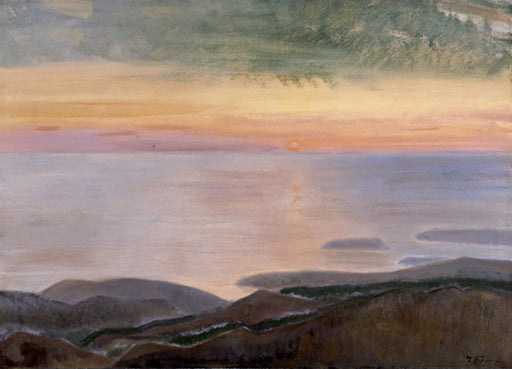Description
Fujishima Takeji, a prominent master of Japanese art, painted "Amanecer" (Sunrise) at a time when the nihonga movement, which merges traditional influences with a modern approach, was at a remarkable stage of development. This work, displayed at the Hiroshima Museum of Art, is a representative example that captures the essence of the transition between night and day, evoking a deep connection with nature and a contemplation of time.
The composition of "Amanecer" is balanced and harmonious, with a visual focus that guides the viewer's gaze from the top of the painting, where a morning sky, softly shaded in tones of blue and warm yellows, unfolds majestically. The interaction between these colors suggests the warmth of the rising sun, a symbol of hope and new beginnings. This color palette creates a serene atmosphere that invites meditation and introspection, characteristics of traditional Japanese aesthetics.
Natural elements are the protagonists in Fujishima's work. The waters reflect the colors of the sky, creating a symbiosis between the sky and the aquatic environment that reinforces the essential connection between land, water, and air. This relationship among different natural elements is frequently observed in Japanese painting, where nature is not merely a backdrop but an active component of the visual narrative. In "Amanecer," the water not only reflects but also plays a crucial role in the viewer's visual experience, transforming into a mirror that captures both the climate and the tranquility of the moment.
Fujishima, known for his skill with oil technique and his influences from Western painting, uses soft and subtle strokes to bring the scene to life. Although no human figures are observed in this work, the absence of figures provides a sense of space and openness. This creates an environment where the viewer can project their own emotions and reflections, fostering a personal interpretation of the dawn.
Fujishima's style is characterized by its focus on the beauty of nature, but also by the way it incorporates a sense of modernity into traditional elements. His work resonates with the principles of the Japanese symbol 'mono no aware', which emphasizes the ephemeral beauty of things. In this context, "Amanecer" is part of a rich tradition of art that seeks to capture the sublime and the transient.
"Amanecer" can be compared to other pieces from the same period where the themes of time and nature intertwine, revealing a constant concern for the representation of light and change. This approach parallels that of Fujishima's contemporaries, who also explored the interactions between light and landscape, highlighting the significant impact these elements can have on the emotional state of the observer.
In conclusion, "Amanecer" by Fujishima Takeji is not only a visual representation of a moment in nature but also a vehicle for contemplation and relaxation, a work that transcends time to connect the viewer with the very essence of natural beauty. The artist's technique and his ability to capture light and color, along with the influence of his cultural context, make this painting a significant piece within the history of Japanese art and an eternal tribute to the sublime blend of tradition and modernity.
KUADROS ©, a famous painting on your wall.
Hand-made oil painting reproductions, with the quality of professional artists and the distinctive seal of KUADROS ©.
Reproduction service of paintings with a satisfaction guarantee. If you are not completely satisfied with the replica of your painting, we will refund 100% of your money.

